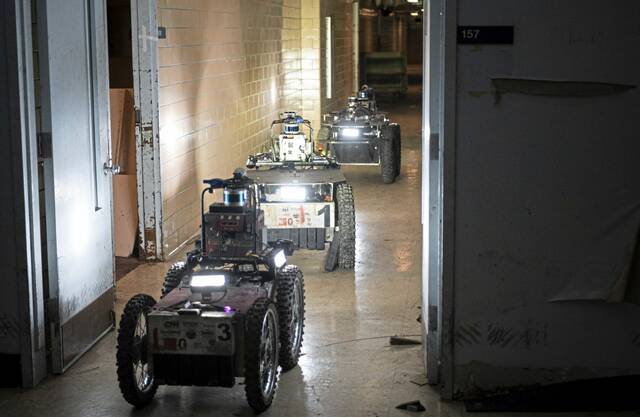Team of Carnegie Mellon students, robots to compete in search-and-rescue mission
Carnegie Mellon University is sending a team of about a dozen robots to a competition testing their navigation of an unknown underground course, meant to simulate search-and-rescue scenarios.
The university’s 20-person team of faculty, students and staff — along with their league of robots — will compete in a Defense Advanced Research Projects Agency (DARPA) challenge next week. DARPA challenges encourage teams to tackle problems with real-world implications, like finding new ways to use robots to enhance search-and-rescue efforts.
Called Team Explorer, the group will compete with their army of autonomous subterranean robots in the final round of the DARPA SubT Challenge in Louisville, Ky., from Sept. 21 through Sept. 24. Team Explorer will take three ground robots, two walking robots and several drones to the competition.
In the DARPA challenge, the team will send robots into a course that simulates a search-and-rescue mission. The autonomous robots will be tasked with navigating tunnels, walking up and down stairs and using sensors to monitor their surroundings. Robots will find objects scattered throughout the course and report the location back to the team.
“The robots are actually making the decisions,” said Sebastian Scherer, an associate research professor at the Robotics Institute. He serves as Team Explorer’s co-lead along with Matt Travers, a systems scientist at the Robotics Institute.
The robots are also able to communicate with one another and map out the terrain. Some of the ground robots will carry drones into the site and deploy them autonomously.
The autonomous subterranean robots have never been exposed to the course before, though there will be two trial rounds next week prior to the 60-minute final. Still, they’ll have to adapt to new surroundings and make decisions without input from human team members.
“At the heart of this challenge is really a problem of exploration. You’re going into an environment you’ve never been into and with that comes a lot of uncertainty. The robot needs to be able to decide what do I do when I face something uncertain? That’s one of the big hurdles in robotics,” Scherer said. “We send the robots in. They have to do the right thing.”
Everything on the robots was custom built, even down to the rims on the wheels of the ground robots, Travers said.
Team Explorer has been working on the project for about three years and competed in two prior rounds of the DARPA contest. In 2018, they finished in first place in the tunnel circuit competition. In 2020, they earned second place in the urban circuit.
The final round will combine elements from the prior rounds. Team Explorer is one of eight teams vying for a share of the $5 million worth of prize money.
The robots have been tested at several local sites including Tour-Ed Mine in Tarentum, Brady’s Ben Underground Storage north of Pittsburgh and Laurel Caverns in Fayette County.
Though the team is gearing up for the DARPA contest, they’re also working to make robots with real-world applications. The robots, which are equipped with various sensors and capabilities, are designed to locate items and people in hard-to-reach or potentially hazardous areas during search-and-rescue efforts. The robots, Travers said, “solve some real problems.”
“For a lot of rescue situations, it takes a long time for people to get in,” because crews must first ensure it’s safe for humans, Scherer said. But robots can go in right away.
Even as they prepare for the robots for the DARPA contest, Scherer and Travers said they’re already eyeing new improvements that would make their creations even more adept at tackling difficult real-world situations. For example, making the drones smaller would allow them to better navigate tight spots.
And making the robots faster would be imperative in search-and-rescue operations.
Julia Felton is a TribLive reporter covering Pittsburgh City Hall and other news in and around Pittsburgh. A La Roche University graduate, she joined the Trib in 2020. She can be reached at jfelton@triblive.com.
Remove the ads from your TribLIVE reading experience but still support the journalists who create the content with TribLIVE Ad-Free.




